Bringing Geography and Geo Survey to Life
The lesson plan and worksheets spoken about in this blog are available to download here.
Before the large-scale return of pupils to classrooms around the country, a group of key worker children in a primary school in Manchester spent their final week exploring the world of urban transport. Using the Get Kids into Survey Transport Exploration Poster, the children investigated the many modes of urban transportation, the infrastructure that enables and supports their use, and the importance of geo survey professionals in helping people to get around – no matter what their chosen form of transport!
Introducing the Project
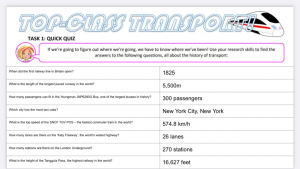 Having taken a good look around the Get Kids into Survey Transport Exploration Poster, the children were set an introductory quiz, all about the world of transportation. The questions focused on superlative aspects of the topic – the longest runway; the widest highway; the highest railway, etc., in order to spark curiosity around modes of transport that might otherwise seem somewhat common place.
Having taken a good look around the Get Kids into Survey Transport Exploration Poster, the children were set an introductory quiz, all about the world of transportation. The questions focused on superlative aspects of the topic – the longest runway; the widest highway; the highest railway, etc., in order to spark curiosity around modes of transport that might otherwise seem somewhat common place.
The quiz was administered and completed electronically, via the same platform that the children were using to support their home learning. This allowed them to do simultaneous online research and to look further into the results they found when their initial discoveries piqued their interests.
Walking to Learn
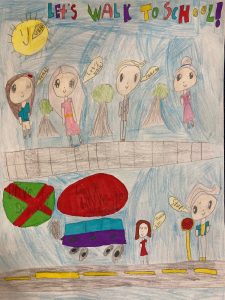 Having completed the quiz, the children returned to the exploration poster for a closer look. They identified walking as a popular mode of transport for the people of Middletown, which sparked discussions about how their own walking activity had increased during periods of lockdown – it being one of the few outdoor activities that they could easily keep up. We discussed the advantages of walking as a mode of transport, both personally and in terms of environmental impact, and we thought about the positive difference it could make if people kept up their new-found enthusiasm for walking after lockdown ended.
Having completed the quiz, the children returned to the exploration poster for a closer look. They identified walking as a popular mode of transport for the people of Middletown, which sparked discussions about how their own walking activity had increased during periods of lockdown – it being one of the few outdoor activities that they could easily keep up. We discussed the advantages of walking as a mode of transport, both personally and in terms of environmental impact, and we thought about the positive difference it could make if people kept up their new-found enthusiasm for walking after lockdown ended.
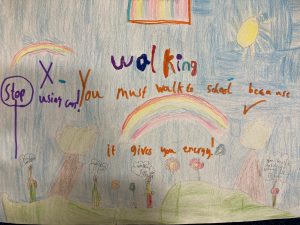 To this end, we looked at initiatives that encourage walking over other means of transportation – especially those that generate pollution. In particular, the children found out about the ‘Living Streets’ organisation, who campaign for better walking infrastructure (which the children identified as an area for geo survey work) while encouraging people to walk wherever they can. One initiative, the ‘WOW Challenge’, rewards children for walking to school with badges and certificates. The children were tasked with producing persuasive materials that would encourage other pupils to keep up their good walking habits upon their return to school.
To this end, we looked at initiatives that encourage walking over other means of transportation – especially those that generate pollution. In particular, the children found out about the ‘Living Streets’ organisation, who campaign for better walking infrastructure (which the children identified as an area for geo survey work) while encouraging people to walk wherever they can. One initiative, the ‘WOW Challenge’, rewards children for walking to school with badges and certificates. The children were tasked with producing persuasive materials that would encourage other pupils to keep up their good walking habits upon their return to school.
Human Sat Nav
To expand upon the idea of walking being a hugely beneficial mode of transport in many different ways, the children were asked to think about the one aspect in which it seemed impossible for walking to come out on top: speed. We explored the idea of using footpaths in order to ‘beat a car’, and pupils were asked to explore their local area to see if they could plot a journey that would be faster on foot than in a car! This really brought to light the importance of well-planned and well maintained pathways, and what is possible in terms of getting from A to B if you have the right path ahead of you! As a group, they managed to find just such a journey – a three minute walk, and a four minute drive!
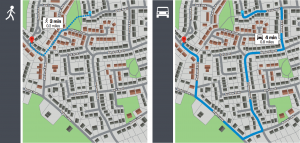
Transport Top Trumps
Returning to the Transport poster, the children were challenged to compare the various means of personal transportation that they could see in action – focusing particularly on those beyond the realm of motorised vehicles. The children were asked to compare the methods of transport they found under four criteria: speed, safety, comfort and exercise. They presented their findings in the form of Top Trump-style fact cards.
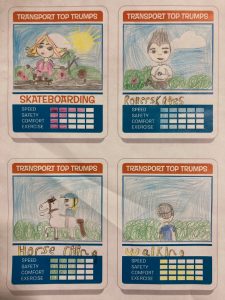
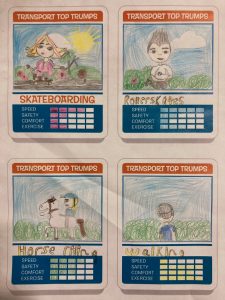
The Ultimate Mode of Transportation
For their final task, the children considered the limitations of the motorised vehicles from the poster. They could see that there were vehicles in the water, on the land, and in the air, but they were all limited to their own geographical zone. But what if this didn’t have to be the case? Might it be possible to design a vehicle that could travel over land, water and air? This was the children’s final task, and their creations did not disappoint!
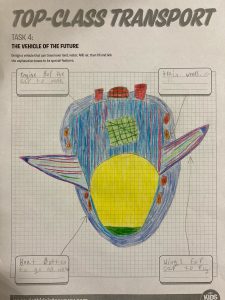 This project, inspired by the Get Kids into Survey Transport Exploration Poster, provided the children with a much greater appreciation for planners and geospatial experts, whose work makes it easy for them to get around, no matter which mode of transport they choose! It also helped to raise awareness of issues like pollution and congestion, and brought to light some of the ways that young people can start to tackle these problems and act in an environmentally responsible way.
This project, inspired by the Get Kids into Survey Transport Exploration Poster, provided the children with a much greater appreciation for planners and geospatial experts, whose work makes it easy for them to get around, no matter which mode of transport they choose! It also helped to raise awareness of issues like pollution and congestion, and brought to light some of the ways that young people can start to tackle these problems and act in an environmentally responsible way.
Report compiled by Mathew Sullivan, FRSA Teacher, Author and Educational Consultant

